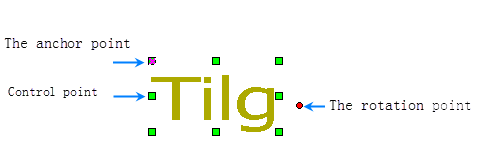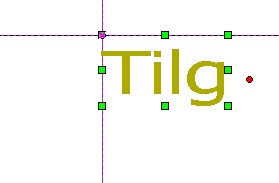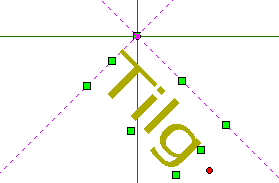The SuperMap Application provides 12 TextAlignments: Upper Left, Upper Middle, Upper Right, Left Baseline, Central Baseline, Right Baseline, Lower Left, Lower Middle, Lower Right, Middle Left, Center, and Middle Right.
Alignment refers to the outward alignment with the anchor point as the alignment starting point, meaning the anchor point serves as the alignment base. When Alignment changes, the anchor point position remains fixed, while Text moves relative to this anchor point according to different alignment types.
 |
 |
 |
When TextAlignment is set to Upper Left, selecting the Text reveals its anchor point at the upper left corner, with the rotation point positioned near the right side of the Text. |
Hover the cursor over the rotation point to observe its visual change. | Select the rotation point, hold the left mouse button (notice another visual change), then rotate on the map. This rotation operation pivots around the anchor point. |
Among the 12 alignment types, 3 are baseline alignments. Baseline primarily applies to English characters, referring to the second guide line in three-line English writing. For example, lowercase letters like abcde sit entirely on the baseline, while letters like g, y, p, j partially extend below it. The baseline positions in Left, Right, and Central Baseline illustrations are marked by guide lines.
The table below demonstrates 12 alignment types and their corresponding anchor points. Auxiliary lines in illustrations are for reference only. Guide lines and anchor points remain fixed while Text shifts according to alignment settings.
Explanation |
Illustration |
Explanation |
Illustration |
Explanation |
Illustration |
| Upper Left: Aligns using the intersection of Text's top horizontal line and left vertical line as anchor point. |  |
Upper Middle: Aligns using the intersection of Text's top horizontal line and central vertical line as anchor point. |  |
Upper Right: Aligns using the intersection of Text's top horizontal line and right vertical line as anchor point. |  |
| Middle Left: Aligns using the intersection of Text's central horizontal line and left vertical line as anchor point. |  |
Center: Aligns using the intersection of Text's central horizontal line and central vertical line as anchor point. |  |
Middle Right: Aligns using the intersection of Text's central horizontal line and right vertical line as anchor point. |  |
| Left Baseline: Aligns using the intersection of Text's baseline and left vertical line as anchor point. |  |
Central Baseline: Aligns using the intersection of Text's baseline and central vertical line as anchor point. |  |
Right Baseline: Aligns using the intersection of Text's baseline and right vertical line as anchor point. |  |
| Lower Left: Aligns using the intersection of Text's bottom horizontal line and left vertical line as anchor point. |  |
Lower Middle: Aligns using the intersection of Text's bottom horizontal line and central vertical line as anchor point. |  |
Lower Right: Aligns using the intersection of Text's bottom horizontal line and right vertical line as anchor point. |  |
The table demonstrates that except for baseline alignments, the anchor points, rotation base points, and corresponding control points coincide in the other 9 alignment types.
In the context above, Text's horizontal and vertical lines (top, center, bottom horizontal lines; left, center, right vertical lines) refer to lines relative to the Text itself, not absolute map coordinates. These Text-relative lines adjust with Text movement and rotation (see example below).
 |
 |
Text's horizontal/vertical lines align with map coordinates. |
When Text rotates, its horizontal/vertical lines rotate accordingly while map coordinates remain fixed. |



